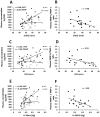Clinical significance of markers of collagen metabolism in rheumatic mitral valve disease
- PMID: 24603967
- PMCID: PMC3948343
- DOI: 10.1371/journal.pone.0090527
Clinical significance of markers of collagen metabolism in rheumatic mitral valve disease
Abstract
Background: Rheumatic Heart Disease (RHD), a chronic acquired heart disorder results from Acute Rheumatic Fever. It is a major public health concern in developing countries. In RHD, mostly the valves get affected. The present study investigated whether extracellular matrix remodelling in rheumatic valve leads to altered levels of collagen metabolism markers and if such markers can be clinically used to diagnose or monitor disease progression.
Methodology: This is a case control study comprising 118 subjects. It included 77 cases and 41 healthy controls. Cases were classified into two groups- Mitral Stenosis (MS) and Mitral Regurgitation (MR). Carboxy-terminal propeptide of type I procollagen (PICP), amino-terminal propeptide of type III procollagen (PIIINP), total Matrix Metalloproteinase-1(MMP-1) and Tissue Inhibitor of Metalloproteinase-1 (TIMP-1) were assessed. Histopathology studies were performed on excised mitral valve leaflets. A p value <0.05 was considered statistically significant.
Results: Plasma PICP and PIIINP concentrations increased significantly (p<0.01) in MS and MR subjects compared to controls but decreased gradually over a one year period post mitral valve replacement (p<0.05). In MS, PICP level and MMP-1/TIMP-1 ratio strongly correlated with mitral valve area (r = -0.40; r = 0.49 respectively) and pulmonary artery systolic pressure (r = 0.49; r = -0.49 respectively); while in MR they correlated with left ventricular internal diastolic (r = 0.68; r = -0.48 respectively) and systolic diameters (r = 0.65; r = -0.55 respectively). Receiver operating characteristic curve analysis established PICP as a better marker (AUC = 0.95; 95% CI = 0.91-0.99; p<0.0001). A cut-off >459 ng/mL for PICP provided 91% sensitivity, 90% specificity and a likelihood ratio of 9 in diagnosing RHD. Histopathology analysis revealed inflammation, scarring, neovascularisation and extensive leaflet fibrosis in diseased mitral valve.
Conclusions: Levels of collagen metabolism markers correlated with echocardiographic parameters for RHD diagnosis.
Conflict of interest statement
Figures






References
-
- Marijon E, Mirabel M, Celermajer DS, Jouven X (2012) Rheumatic Heart Disease. Lancet 379: 953–964. - PubMed
-
- Eisenberg MJ (1993) Rheumatic heart disease in the developing world: prevalence, prevention, and control. Euro Heart J 14: 122–128. - PubMed
-
- World health organization(2004) 2001 Report of a WHO Expert Consultation. Geneva,13–19.
-
- Steer AC, Carapetis JR (2009) Prevention and treatment of rheumatic heart disease in the developing world. Nat Rev Cardiol 6: 689–698. - PubMed
Publication types
MeSH terms
Substances
LinkOut - more resources
Full Text Sources
Other Literature Sources
Medical
Research Materials
Miscellaneous

